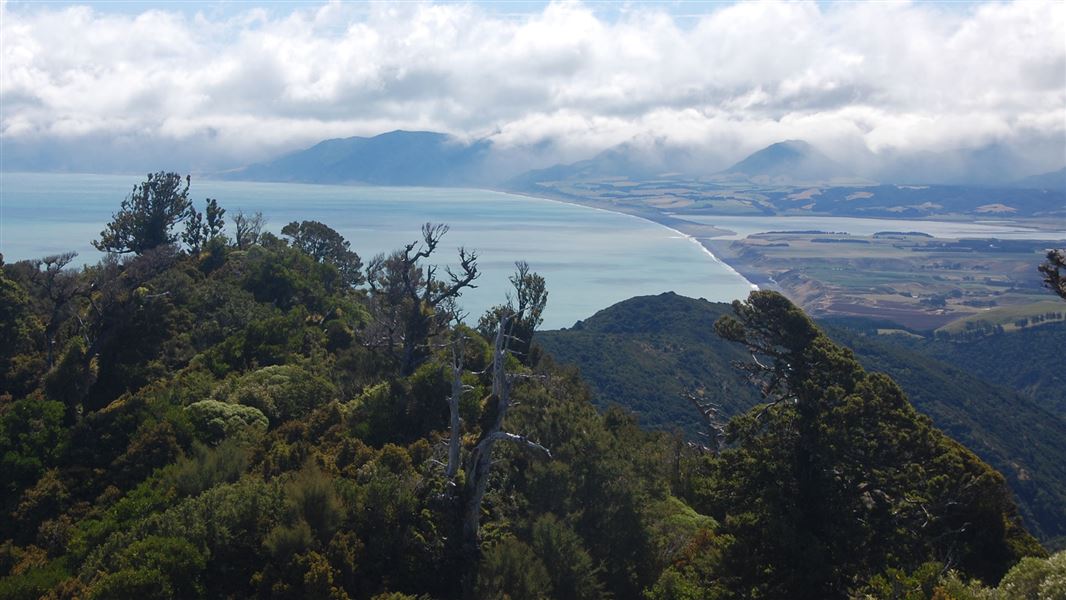Aorangi Forest Park lies between Martinborough in the north and Cape Palliser in the south, covering a large part of the Aorangi mountains. By road the park is around 80 km south of Masterton and 100 km east of Wellington.
Access into the rugged Aorangi Range and the network of tracks within Aorangi Forest Park is gained via several major streams.
The western side of the southern section of the Aorangi Forest Park is the most popular because of the ease of access by road and on foot.
Travelling from the south, turn right off SH2 at Featherston in the Wairarapa and drive east along SH53 to Martinborough. Travelling from the north, turn left at the south end of Greytown and follow the road to Martinborough. From Martinborough, travel south along the Martinborough-Lake Ferry Road for about 50 minutes and then turn off onto the Cape Palliser Road.
Legal public access to the western portion of the park is via the Te Kopi field base; through the Putangirua Pinnacles Scenic Reserve via Whakatomotomo Rd, and the Mangatoetoe Stream along Cape Palliser Road. Legal access to the eastern side can be gained via Haurangi Rd, White Rock Rd and Kaiwaka Rd.
The road further along to Cape Palliser is threatened by erosion below the cliffs at Whatarangi, so drive with caution.
There are numerous other routes into the park for tramping, hunting or shorter trips up the valleys. Access into the Forest Park via private land is by permission from the landowner only.
Dogs
Dogs are permitted in the Forest Park, but must be under the control of the owner at all times. Access for dogs into the park via private land is by permission from the landowner only.
Maps
The Land Information New Zealand (LINZ) topographical maps that cover the park are:
Vegetation
Vegetation patterns in the Aorangi mountains have been modified by fire, wild animals and grazing stock, while land clearance and logging have impacted on the foothills, coastline and river headwaters.
Beech forest dominates the north of the range with hinau and matai characterising the hardwood forests and lower altitudes. Mahoe dominates on the moister soils in gully heads and on stream banks. Fuchsia, makomako, heketara, kohuhu, titoki, rewarewa, rimu, and miro are among other species present.
The shrublands of the river terraces and coastal foothills are generally dominated by tauninu while elsewhere manuka and kanuka are the prevalent species at low altitude. Small areas of sub-alpine shrubland occur on the higher peaks.
There are many diverse rare plants along the Cape Palliser coastline, ranging from the sand tussock Austrofestuca littoralis to Myosotis pygmaea, a tiny gravel bank spring annual.
Wildlife
The fur seal colony at Cape Palliser is the only one in the North Island where breeding is well-established.
The Cape Palliser area also contains breeding sites of variable oystercatcher, banded dotterel and red-billed gull.
Dark sky reserve
The Aorangi Forest park is at the core of the Wairarapa Dark Sky Reserve. For more information about Wairarapa Dark Sky Reserve visit wairarapadarksky.nz.
The park contains Māori occupation sites - a kainga (a resting and eating place for travellers) and the Putangirua Pa site, on a steep outcrop.
The southern block of indigenous forest (7730 ha) was gazetted as a State forest in 1900 and the northern block was added in 1936. The country between the two forest blocks was farmed, but stock was removed in June 1974 when the New Zealand Forest Service took over management and exotic species were planted to control erosion. The area was gazetted a forest park in 1978.
Wairarapa information
| Phone: | +64 3 546 9339 |
| Email: | nelsonvc@doc.govt.nz |
| About: | Whakatū/Nelson Visitor Centre provides visitor information for this area |
